Venezuelan bolívar
| bolívar digital venezolano (Spanish) | |
|---|---|
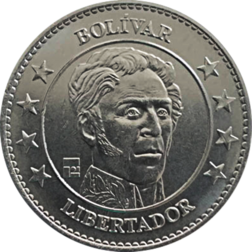 1 bolivar coin | |
| ISO 4217 | |
| Code | VED (numeric: 926) |
| Subunit | 0.01 |
| Unit | |
| Unit | bolívar |
| Plural | bolívares |
| Symbol | Bs. [1] or Bs.D |
| Nickname | bolo(s), luca(s), real(es) |
| Denominations | |
| Subunit | |
| 1⁄100 | céntimo |
| Banknotes | VED series: Bs. 5, Bs. 10, Bs. 20, Bs. 50, Bs. 100, Bs. 200, Bs. 500 |
| Coins | 25, 50 céntimos, Bs. 1 |
| Demographics | |
| User(s) | |
| Issuance | |
| Central bank | Banco Central de Venezuela |
| Website | www |
| Valuation | |
| Inflation | |
| Value | Official rate US$1 = Bs.D 36.8507 (September 25, 2024)[1] Parallel rate US$1 = Bs.D 44.39 (September 25, 2024)[5] |
The bolívar [boˈliβaɾ] is the official currency of Venezuela. Named after the hero of South American independence Simón Bolívar, it was introduced by President Guzman Blanco via the monetary reform of 1879, before which the venezolano was circulating. Due to its decades-long reliance on silver and gold standards, and then on a peg to the United States dollar, it was long considered among the most stable currencies.
Since 1983, the currency has experienced a prolonged period of high inflation, losing value almost 500-fold against the US dollar in the process. The depreciation became manageable in the mid-2000s, but it still stayed in double digits.[6] It was then, on 1 January 2008, that the hard bolívar (bolívar fuerte in Spanish, sign: Bs.F, code: VEF) replaced the original bolívar (sign: Bs; code: VEB) at a rate of Bs.F 1 to Bs. 1,000[1][7] (the abbreviation Bs. is due to the first and the final letters of the plural form of the currency's name, bolívares).
The value of the hard bolívar, pegged to the US dollar, did not stay stable for long despite attempts to institute capital controls. Venezuela entered another period of abnormally high inflation in 2012, which the country has not exited as of April 2023[update]. The central bank stuck to the pegged subsidised exchange rate until January 2018, which was overpriced so people began using parallel exchange rates despite a ban on publishing them. From 2016 to 2019 and again in 2020, the currency experienced hyperinflation for a total period of 38 months.[8]
The rampant inflation prompted another two redenominations. The first occurred in August 2018, when Bs.F 100,000 were exchanged for 1 sovereign bolívar (bolívar soberano in Spanish, sign: Bs.S, code: VES).[9] The second one, dubbed the "nueva expresión monetaria" or new monetary expression, occurred on 1 October 2021, when Bs.S 1,000,000 were exchanged for 1 digital bolívar[a] (bolívar digital in Spanish, sign: Bs.D, code: VED),[10][11] thus making Bs.D 1 worth Bs. 100,000,000,000,000 (1014, or Bs. 100 trillion in short scale).
Both Bs.S and Bs.D currencies are officially in circulation,[12] though the economy has undergone extensive currency substitution, so the majority of transactions happen in US dollars, or, to a lesser extent, the Colombian peso.[8][13][14]
History
[edit]Bolívar
[edit]| Preceded by: Venezolano Reason: unification of circulating currencies Ratio: 1⁄5 venezolano = 1 bolívar |
Currency of Venezuela 31 March 1879 – 31 December 2007 |
Succeeded by: Hard bolívar Reason: inflation Ratio: 1000 bolívares = 1 hard bolívar |
| bolívar (Spanish) | |
|---|---|
| ISO 4217 | |
| Code | VEB |
| Unit | |
| Plural | bolívares |
| Symbol | Bs |
| Denominations | |
| Subunit | |
| 1⁄100 | céntimo |
| Plural | |
| céntimo | céntimos |
| Banknotes | Bs. 1,000, Bs. 2,000, Bs. 5,000, Bs. 10,000, Bs. 20,000, Bs. 50,000 |
| Coins | Bs. 10, Bs. 20, Bs. 50, Bs. 100, Bs. 500, Bs. 1,000 |
| Demographics | |
| User(s) | |
| Issuance | |
| Central bank | Banco Central de Venezuela |
| Website | www |
| This infobox shows the latest status before this currency was rendered obsolete. | |
The bolívar is named after the hero of South American independence Simón Bolívar. The bolívar was introduced by President Guzman Blanco, who around one hundred years after Simón Bolívar's birth, undertook various projects to honour his contribution to Venezuelan history. The coin appeared in the monetary law of 1879, replacing the short-lived venezolano at a rate of five bolívares to one venezolano. Initially, the bolívar was defined on the silver standard, equal to 4.5 g fine silver, following the principles of the Latin Monetary Union. The monetary law of 1887 made the gold bolívar unlimited legal tender, and the gold standard came into full operation in 1910. Venezuela went off gold in 1930, and in 1934, the bolívar exchange rate was fixed in terms of the US dollar at a rate of Bs. 3.914 = US$1, revalued to Bs. 3.18 = 1 US dollar in 1937, a rate which lasted until 1941. Until 18 February 1983 (now called Viernes Negro, Spanish for Black Friday, by many Venezuelans),[15] the bolívar had been the region's most stable and internationally accepted currency. It then fell prey to high devaluation.
Exchange controls were imposed on February 5, 2003, to limit capital flight.[16] The rate was pegged to the US dollar at a fixed exchange rate of Bs. 1,600 to the dollar.
Hard bolívar
[edit]| Preceded by: Bolívar Reason: inflation Ratio: 1000 bolívares = 1 hard bolívar |
Currency of Venezuela 1 January 2008 – 20 August 2018 |
Succeeded by: Sovereign bolívar Reason: hyperinflation Ratio: 100,000 hard bolívares = 1 sovereign bolívar |
| bolívar fuerte (Spanish) | |
|---|---|
| ISO 4217 | |
| Code | VEF |
| Unit | |
| Plural | bolívares fuertes |
| Symbol | Bs.F or Bs. |
| Nickname | bolo(s), luca(s), real(es) |
| Denominations | |
| Subunit | |
| 1⁄100 | céntimo |
| Banknotes | |
| Freq. used | Bs.F 1,000, Bs.F 2,000, Bs.F 5,000, Bs.F 10,000, Bs.F 20,000, Bs.F 100,000[1] |
| Rarely used | Bs.F 2, Bs.F 5, Bs.F 10, Bs.F 20, Bs.F 50, Bs.F 100, Bs.F 500 |
| Coins | |
| Rarely used | Bs.F 1, Bs.F 10, Bs.F 50, and Bs.F 100[1] |
| Demographics | |
| User(s) | |
| Issuance | |
| Central bank | Banco Central de Venezuela |
| Website | www |
| Valuation | |
| Inflation | |
| Pegged with | US$1 = BsF. 248,832 (Dicom auction)[1] (see this section for parallel market rate)[19] |
| This infobox shows the latest status before this currency was rendered obsolete. Coins and low-value banknotes were rendered obsolete by hyperinflation. | |
The government announced on 7 March 2007 that the bolívar would be redenominated at a ratio of 1,000 to 1 on 1 January 2008 and renamed the bolívar fuerte, or hard bolívar in an effort to facilitate the ease of transaction and accounting.[20] The newer name literally means "hard bolívar", as in hard currency, and in reference to an old coin called the peso fuerte worth 10 Spanish reales.[21] The alternate meaning of "strong" was also used by the government in promotional material[22][23] The official exchange rate is restricted to individuals by CADIVI, which imposes an annual limit on the amount available for travel.
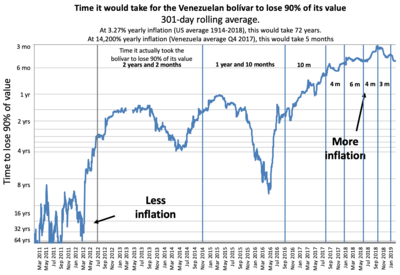
Since the government of Hugo Chávez established strict currency controls in 2003, there have been a series of five currency devaluations, disrupting the economy.[24] On 8 January 2010, the value was changed by the government from the fixed exchange rate of Bs.F 2.15 to Bs.F 2.60 for some imports (certain foods and healthcare goods) and Bs.F 4.30 for other imports like cars, petrochemicals, and electronics.[25] On 4 January 2011, the fixed exchange rate became Bs.F 4.30 for US$1.00 for both sides of the economy. On 13 February 2013 the hard bolívar was devalued to Bs.F 6.30 per US$1 in an attempt to counter budget deficits.[26] On 18 February 2016, President Maduro used his newly granted economic powers to devalue the official exchange rate of the hard bolívar from Bs.F 6.30 per US$1 to Bs.F 10 per US$1, which is a 37% depreciation against the US dollar.[27]
The hard bolívar entered hyperinflation in November 2016.[28]
On January 26, 2018, the government retired the protected and subsidized Bs.F 10 per US$1 exchange rate that was highly overvalued as a result of rampant inflation.[29] On February 5, 2018, the Central Bank of Venezuela announced a 99.6% [sic] devaluation, with the exchange rate going to Bs.F 25,000 per US$. This made the hard bolívar the second-least-valued circulating currency in the world based on the official exchange rate, behind only the Iranian rial, and between September 2017 and August 2018, according to the informal exchange rate, the hard bolívar was the least-valued circulating currency unit in the world.[30][dubious – discuss]
The official exchange rate stood at Bs.F 248,832 to US$1 as of August 10, 2018, making it the least-valued circulating currency in the world based on official exchange rates.[31]
In June 2018, the government authorized a new exchange rate for buying, but not selling, currency. On August 13, 2018, the rate was Bs.F 4,010,000 to US$1, according to ZOOM Remesas.[32]
Sovereign bolívar
[edit]| Preceded by: Hard bolívar Reason: hyperinflation Ratio: 100,000 hard bolívares = 1 sovereign bolívar |
Currency of Venezuela 20 August 2018 – |
| bolívar venezolano (Spanish) | |
|---|---|
| ISO 4217 | |
| Code | VES (numeric: 928) |
| Subunit | 0.01 |
| Unit | |
| Plural | bolívares |
| Symbol | Bs. or Bs.S |
| Nickname | bolo(s), luca(s), real(es) |
| Denominations | |
| Subunit | |
| 1⁄100 | céntimo |
| Banknotes | VES series: Bs.S 10,000, Bs.S 20,000, Bs.S 50,000, Bs.S 200,000, Bs.S 500,000, Bs.S 1,000,000 |
| Demographics | |
| User(s) | |
| Issuance | |
| Central bank | Banco Central de Venezuela |
| Website | www |
| Valuation | |
| Inflation | |
On 22 March 2018, President Nicolás Maduro announced a new monetary reform program, with a planned revaluation of the currency at a ratio of 1,000 to 1.[36] The change was to be made effective from 4 June 2018.[37][38]
In May 2018, the government required prices to be expressed in both hard bolívares and sovereign bolívares at the then-planned rate of 1,000 to 1. For example, one kilogram of pasta was shown with a price of Bs.F 695,000 and Bs.S 695. Prices expressed in the new currency were rounded to the nearest 50 céntimos as that was expected to be the lowest denomination in circulation at launch. The rounding created difficulties because some items and sales qualities were priced at significantly less than Bs.S 0.50; for example a litre of gasoline and a Caracas Metro ticket typically cost Bs.S 0.06 and Bs.S 0.04, respectively.[39]
The change in currency was originally scheduled for June 4, 2018. The President delayed the planned June launch date of the sovereign bolívar, citing from Aristides Maza, "the period established to carry out the conversion is not enough".[40] The revaluation was rescheduled to 20 August 2018, and the rate changed to 100,000 to 1, with prices being required to be expressed at the new rate starting 1 August 2018.[41]
On 20 August 2018, the Maduro government launched the new sovereign bolívar currency,[42] with Bs.S 1 worth Bs.F 100,000. New coins in denominations of 50 céntimos and Bs.S 1, and new banknotes in denominations of Bs.S 2, Bs.S 5, Bs.S 10, Bs.S 20, Bs.S 50, Bs.S 100, Bs.S 200 and Bs.S 500 were introduced.[43] Under the country's official fixed exchange rate to the US dollar the new currency was devalued by roughly 95% compared to the old hard bolívar.[44] The day was declared a bank holiday to allow the banks to adjust to the new currency.[45] Initially, during a transition period the sovereign bolívar was to be run alongside the hard bolívar.[46] However, from the start of the transition, on 20 August, hard bolívar notes of Bs.F 500 and less could not be used; only deposited at banks.[47]
Concurrently with the release of the new currency, the minimum wage was raised to Bs.S 1,800 per month,[48] a 33-fold increase,[49] and sales tax increased from 12% to 16%.[49]
Additionally, the sovereign bolívar was supposed to have a fixed exchange rate to the petro cryptocurrency, with a rate of Bs.S 3,600 to one petro;[50][51] a peg of petro and sovereign bolívar was announced by Maduro as early as August 2018.[52][53] The petro was supposedly tied to the price of a barrel of oil (about US$60 in August 2018).[50][51] As of the end of August 2018, there was no evidence that the cryptocurrency was being traded.[54] Petro was regarded by many as a scam.[55][54][56] On January 15, 2024, Petro was shut down and any remaining holdings were liquidated.[57]
Following the introduction of the sovereign bolívar, inflation increased from 61,463% on 21 August 2018 to 65,320% on 22 August 2018.[55] By 24 August 2018, the introduction of the sovereign bolívar had not prevented hyperinflation.[58] According to inflation analyst Steve Hanke, between 18 August and 21 August 2018, the inflation rate increased from 48,760% to 65,320%.[28][55] In October 2021, the country removed six zeroes from its currency while adapting a newer version of the bolivar currency system under a project known as "Digital bolivar".[59][60]
Digital bolívar
[edit]The bolívar digital, lit. "digital bolívar" was introduced on 1 October 2021 at a rate of Bs.S 1,000,000 to 1 digital bolívar. Since its announcement, the Central Bank has used the abbreviation "Bs." (i.e., not "Bs.D") in examples of prices marked in digital bolívares.[61]
The digital bolívar did not replace the sovereign bolívar, since sovereign bolívar banknotes continued to be accepted at a ratio of 1 million to 1.[62] For example, the Bs.S 500,000 banknote is worth 0.50 digital bolívars, an amount which can also be referred to as 50 céntimos of a digital bolívar.[61]
From October 1, 2021 through 27 April 2022 retailers were required to post prices in both sovereign and digital bolívars,[63] By 2024, however it was more common to see prices posted in "REF" (or "Ref", "ref", etc.), an abbreviation for the word referencia, representing a price in U.S. dollars, which customers can pay in digital and/or sovereign bolívars at the current rate of exchange.
Currency black market
[edit]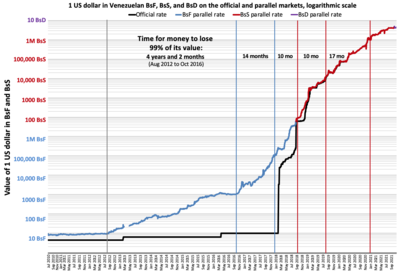
The black (or parallel) market value of the hard bolívar and the sovereign bolívar has been significantly lower than the fixed exchange rate and other rates set by the Venezuelan government (SICAD, SIMADI, DICOM). In November 2013, it was almost one-tenth that of the official fixed exchange rate of Bs.F 6.30 per US dollar.[64] In September 2014, the currency black market rate for the hard bolívar reached 100 VEF/USD;[65] on 25 February 2015, it went over 200 VEF/USD.[66] on 7 May 2015, it was over 275 VEF/USD and on 22 September 2015, it was over 730 VEF/USD.[67] Venezuela still had the highest inflation rate in the world in July 2015.[68] By 3 February 2016, this rate reached 1,000 VEF/USD. This rate surpassed 4,300 VEF/USD on 10 December 2016. It surpassed 10,000 VEF/USD on 28 July 2017, and on 7 September 2017, the rate surpassed 20,000 VEF/USD for the first time. Inflation accelerated, and on 1 December 2017, it reached 100,000 VEF/USD for the first time ever. The rate surpassed 200,000 VEF/USD on 18 January 2018, then 500,000 VEF/USD on 16 April, 1 million VEF/USD on 30 May, 2 million VEF/USD on 7 June, and 5 million VEF/USD on 16 August.[5]
At the time of redenomination on 20 August 2018, the exchange rate was 59.21 VES/USD. By the end of the month it reached 87 VES/USD. The rate then surpassed 100 VES/USD on 3 October 2018, 1,000 VES/USD on 9 January 2019, 10,000 VES/USD on 19 July, 100,000 VES/USD on 6 April 2020, and reached the 1,000,000 VES/USD on 23 November 2020. According to DolarToday, the parallel exchange rate was 4,146,022 VES/USD as of 30 August 2021.[5]
Exchange rate history
[edit]It is illegal to publish the "parallel exchange rate" in Venezuela.[69] One website that has been publishing parallel exchange rates since 2010 is DolarToday, which has also been critical of the Maduro government.[70] This table shows a condensed history of the parallel foreign exchange rate of the Venezuelan bolívar (hard and sovereign) to one United States dollar between 2012 and 2021, according to DolarToday.[71]
| Hard bolívar (Bs.F) Bs.F 1 = Bs. 1,000 |
Sovereign bolívar (Bs.S) Bs.S 1 = Bs.F 100,000 | |||||||||||||||||||||||||||||||||||||||||||||||||||||||||||||||||||||||||||||||||||||||||||||||||||||||||||||||||||||||||||||||||||||||||||||||||||||||||
|---|---|---|---|---|---|---|---|---|---|---|---|---|---|---|---|---|---|---|---|---|---|---|---|---|---|---|---|---|---|---|---|---|---|---|---|---|---|---|---|---|---|---|---|---|---|---|---|---|---|---|---|---|---|---|---|---|---|---|---|---|---|---|---|---|---|---|---|---|---|---|---|---|---|---|---|---|---|---|---|---|---|---|---|---|---|---|---|---|---|---|---|---|---|---|---|---|---|---|---|---|---|---|---|---|---|---|---|---|---|---|---|---|---|---|---|---|---|---|---|---|---|---|---|---|---|---|---|---|---|---|---|---|---|---|---|---|---|---|---|---|---|---|---|---|---|---|---|---|---|---|---|---|---|---|
|
|
|
|
|||||||||||||||||||||||||||||||||||||||||||||||||||||||||||||||||||||||||||||||||||||||||||||||||||||||||||||||||||||||||||||||||||||||||||||||||||||||
Coins
[edit]Bolívar
[edit]
In 1879, silver coins were introduced in denominations of Bs. 1⁄5, Bs. 1⁄2, Bs. 1, Bs. 2, and Bs. 5, together with gold Bs. 20. Gold Bs. 100 were also issued between 1886 and 1889. In 1894, silver Bs. 1⁄4 coins were introduced, followed by cupro-nickel 5 and 12+1⁄2 céntimos in 1896.
In 1912, production of gold coins ceased, whilst production of the Bs.5 ended in 1936. In 1965, nickel replaced silver in the 25 and 50 céntimos, with the same happening to the 1 and 2 bolívares in 1967. In 1971, cupro-nickel 10 céntimo coins were issued, the 12+1⁄2 céntimos having last been issued in 1958. A nickel Bs. 5 was introduced in 1973. Clad steel (first copper, then nickel and cupro-nickel) was used for the 5 céntimos from 1974. Nickel clad steel was introduced for all denominations from 25 céntimos up to 5 bolívares in 1989.
In 1998, after a period of high inflation, a new coinage was introduced in denominations of Bs. 10, Bs. 20, Bs. 50, Bs. 100 and Bs. 500.
The former coins were:
| denomination: | Diameter: | Obverse and reverse: |
|---|---|---|
| bs.10 | 17 mm | 
|
| bs.20 | 20 mm | 
|
| bs.50 | 23 mm | 
|
| bs.100 | 25 mm | 
|
| bs.500 | 28,5 mm | 
|
| bs.1000 | 24 mm | 
|

All the coins had the same design. On the obverse the left profile of the Libertador Simón Bolívar is depicted, along with the inscription "Bolívar Libertador" within a heptagon, symbolizing the seven stars of the flag. On the reverse the coat of arms is depicted, circled by the official name of the country, with the date and the denomination below. In 2001, the reverse design was changed, putting the denomination of the coin at the right of the shield of the coat of arms, surrounded in a semicircle by the official name of the country and the year of its issue below.
Hard bolívar
[edit]Coins of the hard bolívar were in denominations of 1, 5, 10, 12+1⁄2, 25, 50 céntimos, and Bs.F 1. They were quickly rendered obsolete by high inflation. It may be noticed that there was a 12+1⁄2-céntimo coin and a 1-céntimo coin, but no 1⁄2-céntimo coin. Therefore, giving correct change for a purchase of, say, 4+1⁄2 céntimos would require using a 12+1⁄2-céntimo coin and getting 8 céntimos back.
| 2008 Series | |||||||||
|---|---|---|---|---|---|---|---|---|---|
| Denomination | Shape | Composition | Weight | Diameter | Edge | Obverse | Reverse | Obverse image | Reverse image |
| 1 céntimo | Round | Copper-plated steel | 1.36 g | 15 mm | Reeded | Denomination of the coin, the eight stars and waves representing the patterns of the national flag | Coat of arms of Venezuela and the name of the country of emission | 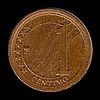 |
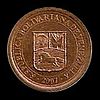
|
| 5 céntimos | Round | Copper-plated steel | 2.03 g | 17 mm | Plain | Denomination of the coin, the eight stars and waves representing the patterns of the national flag | Coat of arms of Venezuela and the name of the country of emission |  |
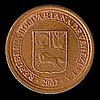
|
| 10 céntimos | Round | Nickel-plated steel | 2.62 g | 18 mm | Reeded | Denomination of the coin, the eight stars and waves representing the patterns of the national flag | Coat of arms of Venezuela and the name of the country of emission | 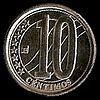 |

|
| 12+1⁄2 céntimos | Round | Nickel-plated steel | 3.93 g | 23 mm | Plain | Denomination of the coin, the eight stars of the national flag and two palm branches | Coat of arms of Venezuela and the name of the country of emission |  |
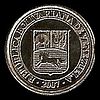
|
| 25 céntimos | Round | Nickel-plated steel | 3.86 g | 20 mm | Plain | Denomination of the coin, the eight stars and waves representing the patterns of the national flag | Coat of arms of Venezuela and the name of the country of emission | 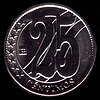 |

|
| 50 céntimos | Round | Nickel-plated steel | 4.3 g | 22 mm | Segmented (Plain and Reeded edges) | Denomination of the coin, the eight stars and waves representing the patterns of the national flag | Coat of arms of Venezuela and the name of the country of emission |  |
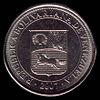
|
| Bs.F 1 | Round | Copper-Nickel center, Brass ring | 8.04 g | 24 mm | Smooth 'BCV1' | Effigy of the Liberator Simón Bolívar, waves representing the patterns of the national flag | Denomination of the coin, the eight stars and the waves representing the patterns of the national flag, the Coat of arms of Venezuela and the name of the country of emission | 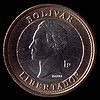 |
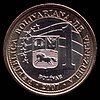
|
In December 2016, it was announced that coins of Bs.F 10, Bs.F 50, and Bs.F 100 would enter circulation. These three coins would replace the banknotes of the same denominations.[72]
| 2016 Series | ||||||||
|---|---|---|---|---|---|---|---|---|
| Denomination | Shape | Composition | Weight | Diameter | Edge | Obverse | Reverse | Obverse & Reverse image |
| 10 bolívares | Round | Nickel-plated steel | 3.5 g | 21.3 mm | Smooth | Effigy of the Liberator Simón Bolívar, waves representing the patterns of the national flag | Coat of arms of Venezuela and the name of the country of emission | 
|
| 50 bolívares | Round | Nickel-plated steel | 5.3 g | 23.5 mm | Smooth | Effigy of the Liberator Simón Bolívar, waves representing the patterns of the national flag | Coat of arms of Venezuela and the name of the country of emission | 
|
| 100 bolívares | Round | Nickel-plated steel | 6.5 g | 25.5 mm | Segmented (Plain and Reeded edges) | Effigy of the Liberator Simón Bolívar, waves representing the patterns of the national flag | Coat of arms of Venezuela and the name of the country of emission | 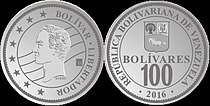
|
Sovereign bolívar
[edit]Sovereign bolívar coins were announced to be produced in denominations of 50 céntimos and Bs.S 1 (Bs.F 50,000 and Bs.F 100,000 respectively). These two coins were worthless by September 2019.
| 2018 Series | ||||||||
|---|---|---|---|---|---|---|---|---|
| Denomination | Shape | Composition | Diameter | Edge | Obverse | Reverse | Obverse image | Reverse image |
| 50 céntimos | Round | Nickel-plated steel | 22 mm | Decorated | Effigy of the Liberator Simón Bolívar, the eight stars of the national flag | Coat of arms of Venezuela, waves representing the patterns of the national flag and the name of the country of emission | 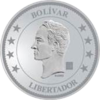 |

|
| 1 bolívar | Round | Copper-Nickel center, Brass ring | 24 mm | - | Effigy of the Liberator Simón Bolívar, the eight stars of the national flag | Coat of arms of Venezuela, waves representing the patterns of the national flag and the name of the country of emission |  |
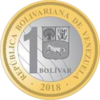
|
Digital bolívar
[edit]Coins of the Digital bolívar were issued on October 1, 2021 in denominations of 25 and 50 céntimos and 1 bolívar. The coins were introduced along with the redenomination of the currency from the Sovereign bolívar to the Digital bolívar.
| 2021 Series | ||||||||
|---|---|---|---|---|---|---|---|---|
| Denomination | Shape | Composition | Diameter | Edge | Obverse | Reverse | Obverse image | Reverse image |
| 25 céntimos | Round | Nickel-plated steel | 21.35 mm | Reeded | Effigy of the Liberator Simón Bolívar and eight stars from the national flag | Denomination and three bands representing the flag of Venezuela | ||
| 50 céntimos | Round | Nickel-plated steel | 23.5 mm | Segmented (Plain and Reeded sections) | Effigy of the Liberator Simón Bolívar and eight stars from the national flag | Denomination and three bands representing the flag of Venezuela | ||
| 1 bolívar | Round | Nickel-plated steel | 25.4 mm | Plain/Smooth | Effigy of the Liberator Simón Bolívar and eight stars from the national flag | Denomination and three bands representing the flag of Venezuela | 
|
|
Banknotes
[edit]Bolívar
[edit]In 1940, the Banco Central de Venezuela began issuing paper money, introducing denominations of Bs. 10, Bs. 20, Bs. 50, Bs. 100 and Bs. 500. Bs. 5 notes were issued between 1966 and 1974, when they were replaced by coins. In 1989, notes for Bs. 1, Bs. 2 and Bs. 5 were issued.
As inflation took hold, higher denominations of banknotes started being introduced: Bs. 1,000 in 1991, Bs. 2,000 and Bs. 5,000 in 1994, and Bs. 10,000, Bs. 20,000 and Bs. 50,000 in 1998. The first Bs. 20,000 banknotes were made in a green color similar to the one of the Bs. 2,000 banknotes, which caused confusion, and new banknotes were made in a new olive green color.
Starting from 2000, banknotes ranging from Bs. 5,000 to Bs. 50,000 were renamed to REPÚBLICA BOLIVARIANA DE VENEZUELA instead of BANCO CENTRAL DE VENEZUELA on the obverse, after the 1999 constitution was adopted. Moreover, banknotes of Bs. 10,000, Bs. 20,000 and Bs. 50,000 were updated in April 2006 after the National Assembly approved changes to the coat of arms, which were made official on March 12, 2006.
The following is a list of former Venezuelan bolívar banknotes:
| Pre-1998 series banknotes (from various series) | |||||
|---|---|---|---|---|---|
| Image | Denomination | Emission Year | Obverse | Reverse | |
| 5 bolívares | 1968 | Simón Bolívar and Francisco de Miranda | National Pantheon of Venezuela | ||
| 10 bolívares | 1968 | Simón Bolívar and Antonio Jose de Sucre | Altar de la Patria, Campo de Carabobo | ||
| 20 bolívares | 1971 | José Antonio Páez | Altar de la Patria, Campo de Carabobo | ||
| 50 bolívares | 1971 | Andrés Bello | Palace of the Academies | ||
| 100 bolívares | 1971 | Simón Bolívar | Federal Legislative Palace | ||
| 500 bolívares | 1981 | Simón Bolívar | A branch of orchids | ||

|

|
1,000 bolívares | 1991 | Simón Bolívar | Signing of the Venezuelan Declaration of Independence |

|

|
2,000 bolívares | 1994 | Antonio José de Sucre | The Battle of Junín |
| 5,000 bolívares | 1994 | Simón Bolívar and his coat of arms | A reproduction of the painting El 19 de Abril de 1810 by Juan Lovera | ||
| 1998 Series | |||||
| [1] | [2] | 1,000 bolívares | 1998 | Simón Bolívar | A picture of National Pantheon in Caracas |
| [3] | [4] | 2,000 bolívares | 1998 | Andrés Bello | A picture of frailejones and a view of the Pico Bolívar |
| [5] | [6] | 10,000 bolívares | 1998 | Simón Bolívar | Teresa Carreño Cultural Complex, Caracas |
| [7] | [8] | 20,000 bolívares | 1998 | Simón Rodríguez and the Angel Falls in the background | A blue-and-yellow macaw and the Angel Falls |
| [9] | [10] | 50,000 bolívares | 1998 | José María Vargas | Central University of Venezuela, Caracas |
| 2000 Series "REPÚBLICA BOLIVARIANA DE VENEZUELA" | |||||
| [11] | [12] | 5,000 bolívares | 2000 | Francisco de Miranda | Picture of two angelfishes and a panorama of the Guri Dam. |
| [13] | [14] | 10,000 bolívares | 2000 | Antonio José de Sucre | A Marpesia petreus butterfly and the Supreme Tribunal of Justice |
| [15] | [16] | 20,000 bolívares | 2001 | Simón Rodríguez and the Angel Falls in the background | A blue-and-yellow macaw and the Angel Falls |
| [17] | [18] | 50,000 bolívares | 2005 | José María Vargas | Central University of Venezuela, Caracas |
Hard bolívar (bolívar fuerte, Bs.F, VEF)
[edit]2008–2016 ("2007")
[edit]New banknotes of the series 2007–2015 with values of Bs.F 2 to Bs.F 100 were issued from 20 March 2007 until 5 November 2015 and became legal tender from 1 January 2008 to 20 August 2018. The greater the values, the longer re-issuing occurred. Only the Bs.F 50 and Bs.F 100 notes were re-issued in November 2015.
- Bs.F 2: March 20, 2007 to October 29, 2013
- Bs.F 5: March 20, 2007 to August 19, 2014
- Bs.F 10: March 20, 2007 to August 19, 2014
- Bs.F 20: March 20, 2007 to August 19, 2014
- Bs.F 50: March 20, 2007 to November 5, 2015[73]
- Bs.F 100: March 20, 2007 to November 5, 2015[73]
The obverse side is portrait-oriented, with the lower half carrying a portrait, while the reverse side is landscape-oriented, the left two thirds showing an animal in front of its habitat.
Re-issues retain the value-specific motifs, but the printing quality is different. The notes are printed by Casa de la Moneda Venezuela in Venezuela.[73]
| 2008 Series - Hard Bolívars (Bs.F, VEF) | ||||||||
|---|---|---|---|---|---|---|---|---|
| Image | Denomi- nation in Bs.F |
Value in Bs. (1879-2007) |
Approx. value in USD at launch (2008)[74] |
Value in USD at demonetization August 2018[75] |
Emission Year | Size (mm) |
Obverse | Reverse |

|
Bs.F 2 | 2,000 | $0.93 | $0.00000033261 1/6,018,869th of $1 |
2007 | 156 × 69 | Francisco de Miranda | Orinoco River Dolphins (Inia geoffrensis) with Coro Dunes in background; Gusano flower |

|
Bs.F 5 | 5,000 | $2.33 | $0.0000008315 1/1,202,846th of $1 |
2007 | Pedro Camejo | Giant armadillo (Priodontes maximus) with the Llanos plains in the background | |

|
Bs.F 10 | 10,000 | $4.66 | $0.000001663 1/601,885th of $1 |
2007 | Cacique Guaicaipuro | American harpy eagle (Harpia harpyja) with the Ucaima Falls at Canaima National Park in the background | |

|
Bs.F 20 | 20,000 | $9.32 | $0.000003326 1/300,942th of $1 |
2007 | Luisa Cáceres de Arismendi | Hawksbill turtle (Eretmochelys imbricata) with Macanao Mountain in the background | |

|
Bs.F 50 | 50,000 | $23.30 | $0.000008315 1/120,285th of $1 |
2007 | Simón Rodríguez | Spectacled bear (Tremarctos ornatos) with Laguna Santo Cristo at Sierra Nevada National Park in the background | |

|
Bs.F 100 | 100,000 | $46.60 | $0.00001663 1/60,216th of $1 |
2007 | Simón Bolívar | Red siskin (Carduelis cucullata) with Cerro El Ávila at El Ávila National Park in the background | |
2016–17
[edit]High inflation, which was a part of Venezuela's economic collapse, caused the hard bolívar's value to plummet. The Bs.F 2 and Bs.F 5 notes were no longer found in circulation due to the hyperinflation, but remained legal tender. By December 2016, the Bs.F 100 note, the largest denomination, was only worth about US$0.23 on the black market.[76]
On 7 December 2016, a new series of banknotes (recolors of the previous notes) in denominations of Bs.F 500, Bs.F 1,000, Bs.F 2,000, Bs.F 5,000, Bs.F 10,000, and Bs.F 20,000 were unveiled to the Venezuelan public.[72][76] Days later on 11 December, President Nicolás Maduro who had been ruling by decree wrote into law that the Bs.F 100 would be pulled from circulation within 72 hours because "mafias" were allegedly storing those particular notes to drive inflation.[77] With more than 6 billion Bs.F 100 notes issued consisting of 46% of Venezuela's issued currency, Maduro enacted an exchange for Venezuelan citizens to transfer all Bs.F 100 notes for Bs.F 100 coins while also blocking international travel to prevent the return of the bolívares that were supposedly stockpiled.[77][78] The government justified the move claiming that the United States was working with crime syndicates to spirit away Venezuela's paper money to warehouses in Europe to cause the fall of the government. The government was thwarting this threat by withdrawing the notes from circulation.[79] On 14 February 2017, Paraguayan authorities uncovered a 30-tonne stash of Bs.F 50 and Bs.F 100 notes totaling Bs.F 1.5 billion on its Brazilian border that had not yet been circulated.[80] According to a United States Department of Defense adviser linked to The Pentagon, the Bs.F 1.5 billion was printed by Venezuela and destined for Bolivia, since unlike the implied exchange rate of thousands of hard bolívares equaling one United States dollar, the exchange rate was approximately 10 hard bolívares per dollar, making the value of the stash 419 times stronger, from US$358,000 to US$150 million.[80] The Pentagon adviser further stated that the Venezuelan government tried to send the newly printed notes to be exchanged by the Bolivian government so Bolivia could pay 20% of its debt to Venezuela, and so Venezuela could use the US dollars for its own disposal.[80]
On 3 November 2017, the Banco Central de Venezuela issued a Bs.F 100,000 note which is similar to the Bs.F 100 note of the 2007 series and the Bs.F 20,000 of the 2016 series, but with the denomination spelled out in full instead of adding an additional three zeros to the number 100. This denomination was worth US$2.42 using the unofficial exchange rate at the date of its release.
New banknotes of the 2016–17 series with values of Bs.F 500 to Bs.F 100,000 were issued from 7 December 2016 until 20 August 2018, the day when the sovereign bolívar was introduced. Notes from Bs.F 5,000 to Bs.F 100,000 were recently re-issued in December 2017.
- Bs.F 500: August 18, 2016 to March 23, 2017
- Bs.F 1,000: August 18, 2016 to March 23, 2017
- Bs.F 2,000: August 18, 2016
- Bs.F 5,000: August 18, 2016 to December 13, 2017
- Bs.F 10,000: August 18, 2016 to December 13, 2017
- Bs.F 20,000: August 18, 2016 to December 13, 2017
- Bs.F 100,000: September 7, 2017 to December 13, 2017,
Maduro announced that after the currency redenomination was carried out on 20 August 2018, these old denominations with a face value of 1,000 hard bolívares or higher would circulate in parallel with the new series of sovereign bolívar notes for a limited time.[81] Banknotes with a face value below BsF. 1,000 were withdrawn from circulation and ceased to be legal tender on 20 August 2018. They had to be deposited in local banks.[82][83]
| 2016-17 Series - Sovereign Bolívars (Bs.F, VEF) | |||||||
|---|---|---|---|---|---|---|---|
| Denomination in Bs.F | Value in Bs.S 20 Aug - 4 Dec 2018 |
Emission Year | Obverse | Reverse | |||
| Bs.F 500 | Bs.S 0.005 | 2016 | Francisco de Miranda | Orinoco River Dolphins (Inia geoffrensis) with Coro Dunes in background; Gusano flower | |||
| Bs.F 1,000 | Bs.S 0.01 | 2016 | Pedro Camejo | Giant armadillo (Priodontes maximus) with the Llanos plains in the background | |||
| Bs.F 2,000 | Bs.S 0.02 | 2016 | Cacique Guaicaipuro | American harpy eagle (Harpia harpyja) with the Ucaima Falls at Canaima National Park in the background | |||
| Bs.F 5,000 | Bs.S 0.05 | 2016 | Luisa Cáceres de Arismendi | Hawksbill turtle (Eretmochelys imbricata) with Macanao Mountain in the background | |||
| Bs.F 10,000 | Bs.S 0.10 | 2016 | Simón Rodríguez | Spectacled bear (Tremarctos ornatos) with Laguna Santo Cristo at Sierra Nevada National Park in the background | |||
| Bs.F 20,000 | Bs.S 0.20 | 2016 | Simón Bolívar | Red siskin (Carduelis cucullata) with Cerro El Ávila at El Ávila National Park in the background | |||
| Bs.F 100,000 | Bs.S 1 | 2017 | Simón Bolívar | Red siskin (Carduelis cucullata) with Cerro El Ávila at El Ávila National Park in the background | |||
2018
[edit]By May 2018, the hard bolívar's banknotes represented very little value and they had become in short supply.[84] Weighing scales could no longer convert mass to price and receipts could no longer fit the numbers on their paper.[85]
In June 2018, seven months after its release, the value of the Bs.F 100,000 note (largest denomination), had its value reduced by 98%, from US$2.42 (in November 2017) to US$0.05, as a result of increasing hyperinflation.
The lower denomination hard bolívar banknotes (up to Bs.F 500) were demonetized on 20 August 2018; with the introduction of the sovereign bolívar. Higher denominations (Bs.F 1,000 and above) remained legal tender during a transition period. On 30 November 2018, it was announced that the remaining denominations of the old currency will be withdrawn from circulation and cease to be legal tender on 5 December 2018.[86]
Sovereign bolívar
[edit]2018
[edit]On 22 March 2018, with a declared state of emergency, a redenomination of the currency was announced.[87] The conversion from hard bolívar to sovereign bolívar banknotes officially occurred on 20 August 2018, with new denominations of Bs.S 2, Bs.S 5, Bs.S 10, Bs.S 20, Bs.S 50, Bs.S 100, Bs.S 200, and Bs.S 500.[88] Four months after entry into circulation, shops and state banks began refusing the Bs.S 2, as its value had significantly declined since the redenomination.[89][90] By November 2019, except for the Bs.S 500, all notes issued in 2018 were worthless.
| 2018 Series - Sovereign Bolívars (Bs.S, VES) | ||||||
|---|---|---|---|---|---|---|
| Denomination in Bs.S | Value in Bs.F | Emission Year | Obverse | Reverse | ||
| 2 bolívares | 200,000 | 2018 | Josefa Camejo | Yellow-crowned amazon parrot (Amazona ochrocephala) with the Morrocoy National Park in the background | ||
| 5 bolívares | 500,000 | 2018 | José Felix Ribas (portrait by Martín Tovar y Tovar) |
Atelopus cruciger with the Henri Pittier National Park in the background | ||
| 10 bolívares | 1,000,000 | 2018 | Rafael Urdaneta | Giant anteater (Myrmecophaga tridactyla) with the Catatumbo lightning in the background | ||
| 20 bolívares | 2,000,000 | 2018 | Simón Rodríguez | Jaguar (Panthera onca) with the Waraira Repano National Park in the background | ||
| 50 bolívares | 5,000,000 | 2018 | Antonio José de Sucre | Cunaguaro (Leopardus tigrinus) with the Península de Paria National Park in the background | ||
| 100 bolívares | 10,000,000 | 2018 | Ezequiel Zamora | Brown spider monkey (Ateles hybridus) with the Guatopo National Park in the background | ||
| 200 bolívares | 20,000,000 | 2018 | Francisco de Miranda | Military macaw (Ara militaris) with the Waraira Repano National Park in the background | ||
| 500 bolívares | 50,000,000 | 2018 | Simón Bolívar | Venezuelan troupial (Icterus icterus) with the Macarao National Park in the background | ||
2019
[edit]Further inflation since the soberano redenomination resulted in the creation of Bs.S 10,000, Bs.S 20,000 and Bs.S 50,000 banknotes in June 2019.[91] Not mentioning inflation, the Central Bank of Venezuela said the introduction of the new banknotes would "complement and optimize" the monetary system and that their purpose was to make payment systems "more efficient".[92] On 23 April 2020, the exchange rate per xe.com was US$1 = 144,697.34 VES; the following day, the rate slid to US$1 = Bs.S 171,140.42.
Banknotes with a narrow segmented security thread were printed by Goznak, those with a wider one were printed elsewhere.
Banknotes of Bs. 10,000, Bs. 20,000, Bs. 50,000, and Bs. 200,000 of the sovereign bolívar will be withdrawn from circulation and cease being legal tender on 25 September 2024.[93]
| 2019 Series - Sovereign Bolívars (Bs.S, VES) | ||||||
|---|---|---|---|---|---|---|
| Image | Denomination in Bs.S | Value in Bs.D | Emission Year | Obverse | Reverse | Valid until |
| [94] | 10,000 bolívares | 0.01 | 2019 | Simón Bolívar | "Mausoleum of the Liberator" Simón Bolívar | 25 September 2024 |
| [95] | 20,000 bolívares | 0.02 | 2019 | Simón Bolívar | "Mausoleum of the Liberator" Simón Bolívar | 25 September 2024 |
| [96] | 50,000 bolívares | 0.05 | 2019 | Simón Bolívar | "Mausoleum of the Liberator" Simón Bolívar | 25 September 2024 |
2020
[edit]As of December 2020, the highest denomination banknote (Bs.S 50,000) was worth less than US$0.05[97] and the minimum wage is Bs.S 1,200,000 (about US$1) per month.[98] By September 2020, all sovereign bolivar banknotes (Bs.S 2 to Bs.S 500) issued on 20 August 2018 were deemed worthless. Venezuelan officials are planning a new Bs.S 100,000 note.[99] Meanwhile, as of 16 December 2020, the exchange rate was over 1 million bolivares to one US dollar.[100]
2021
[edit]On 5 March 2021, the Central Bank of Venezuela introduced 3 new denominations: Bs.S 200,000, Bs.S 500,000 and Bs.S 1,000,000 which were made available to the general public on 8 March 2021.[101] The Bs.S 1,000,000 note was only worth US$0.52 at the time of the announcement.[102]
By late May 2021 the exchange rate had risen to over 3 million sovereign bolívares to one US dollar.[100]
According to a July 2021 Bloomberg article, Venezuela plans to redenominate the bolívar at a ratio of 1,000,000:1 in August 2021, effectively removing six zeros from the denominations. The current largest denomination banknote is 1,000,000 bolívares, expressed on the note with a predominant 1 followed by the descriptive millón de bolívares. It is therefore likely that the bank intends to retain the bolívar currency name while reusing the existing note designs.[103]
| 2021 Series - Sovereign Bolívars (Bs.S, VES) | ||||||
|---|---|---|---|---|---|---|
| Image | Denomination in Bs.S | Value in Bs.D | Emission Year | Obverse | Reverse | Valid until |
| [104] | 200,000 bolívares | 0.20 | 2020 | Simón Bolívar | "Mausoleum of the Liberator" Simón Bolívar | 25 September 2024 |
| [105] | 500,000 bolívares | 0.50 | 2020 | Simón Bolívar | "Mausoleum of the Liberator" Simón Bolívar | current |
| [106] | 1,000,000 bolívares | 1.00 | 2020 | Simón Bolívar | Entrance to the Monument to the Motherland on Carabobo Fields; Battle of Carabobo | current |
Digital bolívar
[edit]Banknotes of 5, 10, 20, 50, and 100 digital bolívares were introduced in 2021,[107] all bearing similar motifs but different colors.
In August 2024, banknotes of 200 and 500 bolívares were introduced.[108]
| 2021 Series - Digital Bolívars (VED) | ||||||
|---|---|---|---|---|---|---|
| Image | Denomination | Emission Year | Color | Obverse | Reverse | |
| 5 bolívares | 2021 | brown | Simón Bolívar | Entrance to the Monument to the Motherland on Carabobo Fields; Battle of Carabobo | ||
| 10 bolívares | purple | |||||
| 20 bolívares | orange | |||||
| 50 bolívares | green | |||||
| 100 bolívares | red-violet | |||||
| 200 bolívares | 2024 | purple/yellow | Three portraits of Simón Bolívar | Rafael Urdaneta bridge at Tablazo Strait outlet of Lake Maracaibo; Battle of Lake Maracaibo | ||
| 500 bolívares | yellow/green | |||||
| Current VED exchange rates | |
|---|---|
| From Google Finance: | AUD CAD CHF CNY EUR GBP HKD JPY USD INR EUR JPY |
| From Yahoo! Finance: | AUD CAD CHF CNY EUR GBP HKD JPY USD INR EUR JPY |
| From XE.com: | AUD CAD CHF CNY EUR GBP HKD JPY USD INR EUR JPY |
| From OANDA: | AUD CAD CHF CNY EUR GBP HKD JPY USD INR EUR JPY |
Notes
[edit]See also
[edit]References
[edit]- ^ a b c d e f "Banco Central de Venezuela". bcv.org.ve (in Spanish).
- ^ "Venezuela - Inflation rate 2022". Statista. Retrieved 2021-10-05.
- ^ "La inflación acumulada en 2020 en Venezuela fue de 2.959,8%, según el BCV". EFE (in Spanish). Retrieved 2021-10-05.
- ^ "José Guerra: Seguimos en Hiperinflación. La inflación al cierre del 2020 en Venezuela fue de 3713%". Observatorio Venezolano de Finanzas (in Spanish). 6 January 2021. Retrieved 2021-10-05.
- ^ a b c "Indicadores Economía Venezolana". dolartoday.com (in Spanish). 15 December 2023.
- ^ "Inflation rate, average consumer prices - Venezuela". International Monetary Fund. Retrieved 2021-10-05.
- ^ "Venezuela Introduces New Currency". Gata. 2008-01-01. Retrieved 2008-02-04.
- ^ a b c Silva, Vanessa; Long, Gideon (2021-10-01). "Venezuela lops another six zeros off its currency". Financial Times. Archived from the original on 2022-12-10. Retrieved 2021-10-05.
- ^ Cohen, Benjamin J. (22 August 2018). "Venezuela's "desperate" currency devaluation won't save its economy from collapse". The Conversation. Retrieved 2021-10-05.
- ^ Zerpa, Fabiola; Yapur, Nicolle (2021-10-12). "Venezuela burns through cash to shore up new bolivar". Bloomberg News.
- ^ "List one: Currency, fund and precious metal codes" (PDF). SIX Financial Information AG. 1 October 2021.
- ^ "Billetes del cono monetario actual coexistirán con los billetes y monedas de la Nueva Expresión Monetaria". Banco Central de Venezuela. 2021-09-03. Retrieved 2021-10-05.
- ^ "Venezuela introduces new currency with 6 fewer zeros". Associated Press. 2021-10-01. Retrieved 2021-10-05.
- ^ "Au Vénézuela, miné par l'hyperinflation, la monnaie nationale perd six zéros d'un coup". Le Monde.fr (in French). 2021-10-01. Retrieved 2021-10-05.
- ^ "The weakening of the "strong bolívar"". The Economist. 2010-01-14. Retrieved 2016-12-10.
- ^ "Sistema Cambiario". Archived from the original on 2011-04-09. Retrieved 2011-04-09.
- ^ "Home". planetbanknote.com.
- ^ "Asamblea Nacional". República Bolivariana de Venezuela (in Spanish). Archived from the original on 15 August 2018. Retrieved 22 August 2018.
- ^ "Calculadora Dolar Today". Dolar Today. May 8, 2018.
- ^ "Currency of Venezuela – Venezuela's new currency the Venezuelan Bolívar fuerte". Republica-de-venezuela.com. Retrieved 2016-12-10.
- ^ Numismatic Catalog of Venezuela. "Coins in Pesos Fuerte". Retrieved 2008-02-04.
- ^ television advertisements Bolivar Fuerte Bs.F for the new currency repeatedly use "fuerte" as meaning "strong" such as in "Una economía fuerte" (a strong economy) and "¡Aquí hay fuerza!" (There's strength in this!)
- ^ Rueda, Jorge (2008-01-01). "Venezuela cuts three zeros off bolivar currency". Reuters. Retrieved 2008-02-04.
- ^ Mander, Benedict (10 February 2013). "Venezuelan devaluation sparks panic". Financial Times. Archived from the original on 2022-12-10. Retrieved 11 February 2013.
- ^ "Venezuela will slash value of currency, the bolivar". BBC. 2010-01-09. Retrieved 2010-01-09.
- ^ "Chavez Devaluation Puts Venezuelans to Queue on Price Raise". Bloomberg. 11 February 2013. Archived from the original on February 17, 2013. Retrieved 11 February 2013.
- ^ Holodny, Elena (18 February 2016). "Venezuela raises gas prices 6,200%". Business Insider. Retrieved 18 February 2016.
- ^ a b Hanke, Steve (18 August 2018). "Venezuela's Great Bolivar Scam, Nothing but a Face Lift". Forbes. Retrieved 19 August 2018.
- ^ "Venezuela eliminates heavily subsidized DIPRO forex rate". Reuters. 30 Jan 2018. Retrieved 2018-01-30.
- ^ "Venezuela announces 99.6 percent devaluation of official forex rate". Reuters. 5 February 2018. Retrieved 20 August 2018.
- ^ "Banco Central de Venezuela |". bcv.org.ve.
- ^ "Casa de Cambio ZOOM". Retrieved 2018-06-23.
- ^ "Venezuela - Inflation rate 2022". Statista. Retrieved 2021-10-05.
- ^ "La inflación acumulada en 2020 en Venezuela fue de 2.959,8%, según el BCV". EFE (in Spanish). Retrieved 2021-10-05.
- ^ "José Guerra: Seguimos en Hiperinflación. La inflación al cierre del 2020 en Venezuela fue de 3713%". Observatorio Venezolano de Finanzas (in Spanish). 6 January 2021. Retrieved 2021-10-05.
- ^ López, Abel (2018-03-22). "Maduro anuncia nueva reconversión monetaria". El Nacional (in Spanish). Retrieved 2018-03-22.
- ^ "Venezuela to revalue ailing bolivar currency from June 4". Nasdaq. 2018-03-22. Archived from the original on 2018-03-23. Retrieved 2018-03-22.
- ^ "Ya está en Gaceta Oficial decreto de reconversión monetaria". Panorama (in Spanish). Retrieved 2018-03-26.
- ^ Web, El Nacional (2018-04-29). "Comenzaron a aparecer productos con precios el bolívares soberanos". El Nacional (in Spanish). Retrieved 2018-04-30.
- ^ WEB, EL NACIONAL (2018-05-29). "Maduro pospone entrada en vigencia de la reconversión monetaria". El Nacional (in Spanish). Retrieved 2018-05-29.
- ^ "Inflation-hit Venezuela to remove five zeros from currency". Deutsche Welle. 26 July 2018. Retrieved 2018-07-26.
- ^ "With 1,000,000% inflation, Venezuela slashes five zeroes from its bills". 26 July 2018. Retrieved 22 August 2018.
- ^ Litzmayer, Owen (5 Apr 2018). "Venezuela | Banknote News". www.banknotenews.com. Retrieved 2018-05-08.
- ^ Hopps, Kat (21 August 2018). "Venezuela crisis: How much is the bolivar worth today? Bs to USD to GBP". Retrieved 22 August 2018.
- ^ Sterling, Joe (2018-08-23). "Venezuela issues new currency, amid hyperinflation and social turmoil". CNN. Retrieved 2018-08-23.
- ^ "Venezuela rolls out new currency amid rampant hyperinflation". Al Jazeera. 20 August 2018. Retrieved 22 August 2018.
- ^ "Venezuela - Bolívar soberano transition". MRI Guide. August 15, 2018.
- ^ Venezuela just devalued the bolivar by 95% and pegged it to a cryptocurrency - Business Insider
- ^ a b "Venezuela hikes wages ahead of monetary overhaul". Washington Post. 2018-08-17. Archived from the original on 2019-06-07. Retrieved 2018-08-24.
- ^ a b Lam, Eric (20 August 2018). "Here's What Maduro Has Said of Venezuela's Petro Cryptocurrency". Bloomberg News.
- ^ a b Phillips, Tom (20 August 2018). "Venezuela devalues currency and raises minimum wage by 3,000%". the Guardian. Retrieved 22 August 2018.
- ^ Venezuela "paralysed" by launch of sovereign bolivar currency, BBC News, 21 August 2018
- ^ "Venezuela rolls out new currency amid rampant hyperinflation". www.aljazeera.com.
- ^ a b Ellsworth, Brian (30 August 2018). "Special Report: In Venezuela, new cryptocurrency is nowhere to be found". Reuters. Retrieved 7 September 2018.
- ^ a b c Mak, Aaron (22 August 2018). "Venezuela Is About to Become the First Country to Peg Its Currency to a Cryptocurrency. Don't Believe the Hype". Slate Magazine. Retrieved 23 August 2018.
- ^ Moskvitch, Katia (22 August 2018). "Inside the bluster and lies of Petro, Venezuela's cryptocurrency scam". Wired. Retrieved 11 October 2018.
- ^ "Venezuela Kills Off Petro Cryptocurrency". Barron's. 2024-01-12. Archived from the original on 19 January 2024. Retrieved 2024-01-19.
- ^ "Venezuela: New currency fails to curb hyperinflation". Al Jazeera. Retrieved 2018-08-24.
- ^ "A million to 1: Venezuela's currency losing 6 zeros". AP NEWS. 2021-08-05. Retrieved 2021-08-30.
- ^ "Venezuela le quitará 6 ceros a su moneda y el bolívar soberano se llamará bolívar digital". BBC News Mundo (in Spanish). Retrieved 2021-08-30.
- ^ a b "¿Cómo pagar en la Nueva Expresión Monetaria?". Banco Central de Venezuela. 24 September 2021. Retrieved 20 June 2024.
- ^ Venezuela - New banknotes denominated in bolívares "digitales" in October.
- ^ "Resolución N° 22-04-01". Banco Central de Venezuela. 21 April 2022. Retrieved 20 June 2024.
- ^ "Stuck in Venezuela with those currency exchange blues". Los Angeles Times. 12 November 2013. Retrieved 7 January 2014.
- ^ "Venezuela bolivar hits record low 100/U.S. dollar on black market". Reuters. 26 September 2014. Retrieved 5 October 2014.
- ^ "Venezuela's bolívar tumbles beyond 200 mark". Financial Times. 25 February 2015. Archived from the original on 2022-12-10. Retrieved 28 April 2015.
- ^ "El precio "REAL" del Dolar paralelo en Venezuela". DolarToday.com. 15 February 2013. Archived from the original on 15 February 2013. Retrieved 8 February 2021.
- ^ Pardo, Daniel (8 July 2015). "Living with Venezuela's high inflation". BBC News. UK. Retrieved 7 August 2015.
- ^ Simon Romero (February 9, 2008). "In Venezuela, Faith in Chávez Starts to Wane". The New York Times.
- ^ Otis, John (12 December 2013). "Venezuela forces ISPs to police Internet". Committee to Protect Journalists. Retrieved May 15, 2015.
- ^ Custom. Dolar Today
- ^ a b "Ampliación del cono monetario" (PDF) (Press release) (in Spanish). Banco Central de Venezuela. 20 December 2016. Archived from the original (PDF) on 2016-12-20. Retrieved 22 August 2018.
- ^ a b c banknotes > Venezuela > series 2007–2015 colnect.com, retrieved 12 December 2016. – Specific (re-)issuing date above pair of signatures above portrait.
- ^ "Exchange Rate to U.S. Dollar for Venezuela". Federal Reserve Bank of St. Louis. 31 August 2012. Retrieved 6 August 2024.
- ^ Note, the notes were demonetized on August 20, when an artificial exchange rate of VES 1 = VEF 100,000 = $0.40. Figures here are based on the exchange rate of August 24, which was a more realistic VES 1 = VEF 100,000 = $0.01663; Source: "Venezuelan Bolivar (VES) To US Dollar (USD) Exchange Rate History for 2018". www.exchange-rates.org. Retrieved 6 August 2024.
- ^ a b "Venezuela's new banknotes". Deutsche Welle. 8 December 2016. Retrieved 9 December 2016.
- ^ a b "Venezuela's Maduro orders 100-unit banknotes out of circulation". AFP. 11 December 2016. Retrieved 12 December 2016.
- ^ "Venezuela pulls most common banknote from circulation to 'beat mafia'". The Guardian. 11 December 2016. Retrieved 12 December 2016.
- ^ "Declaring war on common sense, Venezuela bans its own money". Washington Post. Dec 15, 2016.
- ^ a b c Coutinho, Leonardo (23 February 2017). "Veja: Venezuela y Bolivia son sospechosas de esquema estatal de lavado". Eju TV (in European Spanish). Retrieved 24 February 2017.
- ^ "Maduro: El nuevo cono monetario va a coexistir con el viejo "hasta su extensión"". www.noticierodigital.com. Retrieved 2018-08-14.
- ^ "Banco Central de Venezuela on Twitter". Twitter. Retrieved 2018-08-14.
- ^ WEB, EL NACIONAL (2018-08-14). "Billetes inferiores a 1.000 bolívares no tendrán valor a partir del 20A". El Nacional (in Spanish). Retrieved 2018-08-14.
- ^ "Venezuelans Are Paying a 100% Premium for Cash". Bloomberg. 2018-03-02. Retrieved 2018-04-05.
- ^ "Venezuela's Hyperinflation Is Breaking Deli Scales". Bloomberg. 2018-03-14. Retrieved 2018-04-05.
- ^ "Bolívar Fuerte circulará hasta el miércoles 5 de diciembre | En la Agenda | 2001.com.ve". 2001.com.ve. Retrieved 2018-11-30.
- ^ "Resolución N° 18-03-01 RM - Mediante la cual se dictan las Normas que Rigen en el Proceso de Reconversión Monetaria". Banco Central de Venezuela (in Spanish). 2018-04-30. Retrieved 2020-08-31.
- ^ "Inició el Programa de Recuperación Económica con el Bolívar Soberano". Banco Central de Venezuela (in Spanish). 2018-08-21. Retrieved 2020-08-31.
- ^ Krystian (2019-01-06). "Billetes de Bs.S 2 no es aceptado ni en bancos del Estado". Descifrado (in European Spanish). Retrieved 2019-01-08.
- ^ C, Manuel Tomillo (2019-01-06). "Ya ni los bancos del Estado quieren aceptar los devaluados billetes de Bs.S 2". Caraota Digital (in European Spanish). Retrieved 2019-01-08.[permanent dead link]
- ^ "Tres nuevos billetes se incorporan al Cono Monetario vigente". Banco Central de Venezuela. Retrieved 2019-06-12.
- ^ "Venezuela adds bigger bank notes due to hyperinflation". Reuters. 2019-06-12. Archived from the original on April 14, 2020. Retrieved 2019-06-13.
- ^ egrasso (2024-09-04). "Gaceta Oficial N° 42.952: Billetes del cono monetario "Bolívar Soberano" de Bs 10.000, 20.000, 50.000 y 200.000 circularán hasta el #25sep 2024". Finanzas Digital (in Spanish). Retrieved 2024-09-10.
- ^ "P-NEW". Banknote.ws. 2019-01-22. Retrieved 2020-06-04.
- ^ "P-NEW". Banknote.ws. 2019-01-22. Retrieved 2020-06-04.
- ^ "P-NEW". Banknote.ws. 2019-01-22. Retrieved 2020-06-04.
- ^ "Convert Venezuelan Bolívar to United States Dollar | VES to USD Currency Converter". Retrieved 2020-11-30.
- ^ "Lo que se sabe del aumento del salario mínimo y qué implica para los venezolanos". 12 November 2020. Retrieved 2020-11-30.
- ^ Laya, Patricia; Zerpa, Fabiola (5 October 2020). "Venezuela Planning New 100,000-Bolivar Bills Worth Just $0.23". Bloomberg. Retrieved 22 November 2020.
- ^ a b "1 USD to VES - US Dollar to Venezuelan Bolívar Exchange Rates".
- ^ "BCV amplía Cono Monetario vigente con incorporación de tres nuevos billetes". Banco Central de Venezuela. Retrieved 6 March 2021.
- ^ "Venezuela to introduce 1-million-bolivar bill". dw.com. Retrieved 6 March 2021.
- ^ Laya, Patricia (2021-07-01). "Venezuela to Cut Six Zeroes Off Bolivar to Simplify Transactions". Bloomberg.com. Retrieved 2021-08-30.
- ^ "P-NEW". Banknote.ws. 2020-09-03. Retrieved 2020-06-04.
- ^ "P-NEW". Banknote.ws. 2019-01-22. Retrieved 2020-06-04.
- ^ "P-NEW". Banknote.ws. 2019-01-22. Retrieved 2020-06-04.
- ^ ""What Is the Venezuelan Bolivar Digital (Digitales)?"". Banknote World. 2022-05-11. Retrieved 2023-04-22.
- ^ "Banco Central de Venezuela lanza dos nuevos billetes". AP News (in Spanish). 2024-08-17. Retrieved 2024-09-10.
Bibliography
[edit]- Krause, Chester L.; Clifford Mishler (1991). Standard Catalog of World Coins: 1801–1991 (18th ed.). Krause Publications. ISBN 0873411501.
- Pick, Albert (1994). Bruce, Colin R. II; Shafer, Neil (eds.). Standard Catalog of World Paper Money: General Issues (7th ed.). Krause Publications. ISBN 0-87341-207-9.
